brought to you by: Dave Williams
This page: www.bacomatic.org/~dw/fordv8/yblock/yblock.htm
Main page: http://www.bacomatic.org/~dw/index.htm
Last Updated: 18 Sep 2003
Author: Dave Williams; dlwilliams=aristotle=net
 This is a 1954 passenger car engine, 239 cubic inches. The tube looping
over the front is the exhaust crossover. Yes, it was easy to burn yourself on
it if you were working on the engine. Note the petcock to drain the water
jacket, the recessed bellhousing for the starter Bendix, and the 3-blade fan
like a flathead.
This is a 1954 passenger car engine, 239 cubic inches. The tube looping
over the front is the exhaust crossover. Yes, it was easy to burn yourself on
it if you were working on the engine. Note the petcock to drain the water
jacket, the recessed bellhousing for the starter Bendix, and the 3-blade fan
like a flathead.
 Front cutaway. Note no oil galleries for the lifters - all Y-blocks were
solid lifter engines; valve adjustment was be a ball-head screw in the rocker
arm. The oil pump is external on the driver's side. You can see the main oil
gallery inside the block by the oil filter. Note the extensively baffled oil
pan.
Front cutaway. Note no oil galleries for the lifters - all Y-blocks were
solid lifter engines; valve adjustment was be a ball-head screw in the rocker
arm. The oil pump is external on the driver's side. You can see the main oil
gallery inside the block by the oil filter. Note the extensively baffled oil
pan.
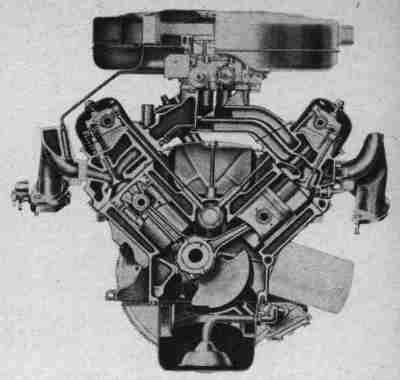 Later 292 inch engine. Large air filter housing dampens noise.
Later 292 inch engine. Large air filter housing dampens noise.
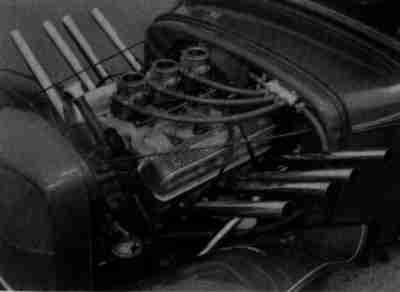 Y-block in a racing car, circa 1959. Multiple carburetion and neat exhaust
stacks were the hot setup.
Y-block in a racing car, circa 1959. Multiple carburetion and neat exhaust
stacks were the hot setup.
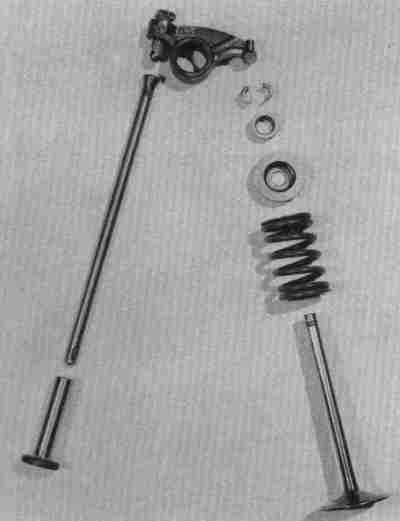 Y-block valvetrain. Mushroom lifter, solid steel pushrod, forged steel rocker
with adjustment screw, two-piece valve retainer to allow the valve to rotate
to reduce seat wear.
Y-block valvetrain. Mushroom lifter, solid steel pushrod, forged steel rocker
with adjustment screw, two-piece valve retainer to allow the valve to rotate
to reduce seat wear.
When the FE came out it used a very similar rocker arm, and the two-piece
retainer lived on in the 5.0 into the 1990s.
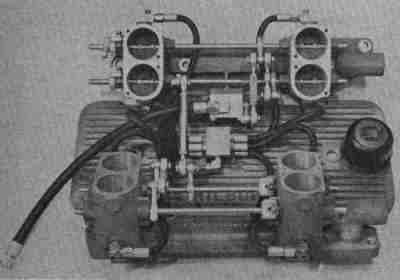 Hilborn fuel injection intake for Y-blocks, circa early '60s.
Hilborn fuel injection intake for Y-blocks, circa early '60s.
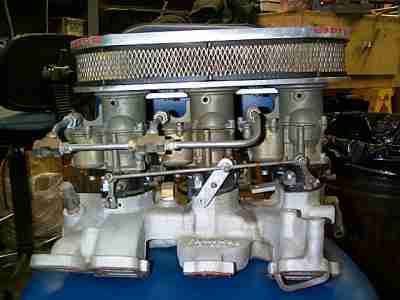 3x2 Stromberg intake from Edelbrock, all dressed up and ready to go.
3x2 Stromberg intake from Edelbrock, all dressed up and ready to go.
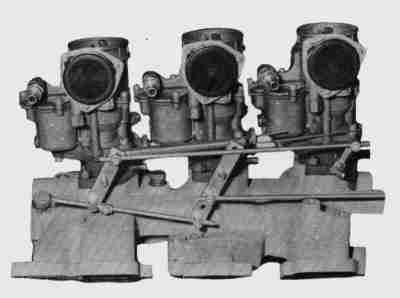 Staged linkage on another Edelbrock 3x2.
Staged linkage on another Edelbrock 3x2.
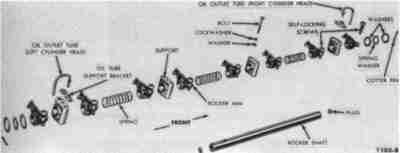 Rocker shaft oiling system. Separate tubes took oil from the heads to the
rocker shafts. All Y-blocks were solid lifter engines.
Rocker shaft oiling system. Separate tubes took oil from the heads to the
rocker shafts. All Y-blocks were solid lifter engines.
 Angle cutaway. The Y-block casting looks quite similar to the old flathead V8
casting. It was probably done deliberately to simplify changeover to the new
engine; Ford had built flathead V8s since 1932 and they weren't used to doing
new things. Head bolts are attached to the water jackets, not the cylinder
bores, to prevent bore distortion when the bolts are torqued.
Angle cutaway. The Y-block casting looks quite similar to the old flathead V8
casting. It was probably done deliberately to simplify changeover to the new
engine; Ford had built flathead V8s since 1932 and they weren't used to doing
new things. Head bolts are attached to the water jackets, not the cylinder
bores, to prevent bore distortion when the bolts are torqued.
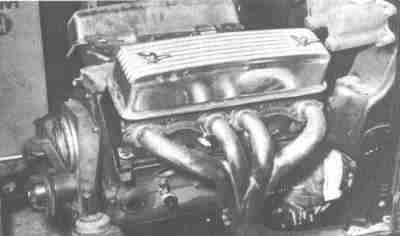 Nice set of custom headers on a 312. Note lack of a harmonic balancer,
location of oil pressure sender, front engine mounts. The oil pump goes in
the hole between the engine mount and the sender.
Nice set of custom headers on a 312. Note lack of a harmonic balancer,
location of oil pressure sender, front engine mounts. The oil pump goes in
the hole between the engine mount and the sender.
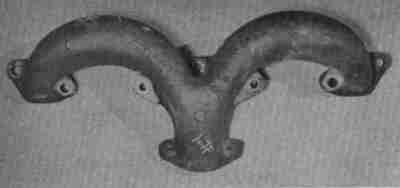 These cast iron ram's-horn exhaust manifolds were from a Ford racing kit.
These cast iron ram's-horn exhaust manifolds were from a Ford racing kit.
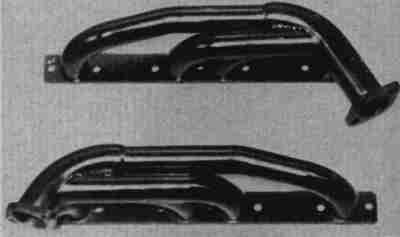 Hedman Hedders for 292 or 312 engine in '55 and '56 Ford passenger cars.
Hedman Hedders for 292 or 312 engine in '55 and '56 Ford passenger cars.
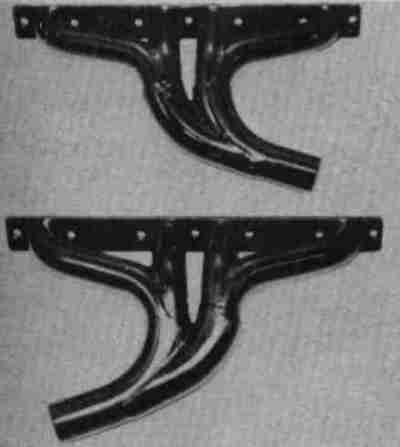 Hedman Hedders for 292 or 312 engine in '55 through '57 Thunderbird.
Hedman Hedders for 292 or 312 engine in '55 through '57 Thunderbird.
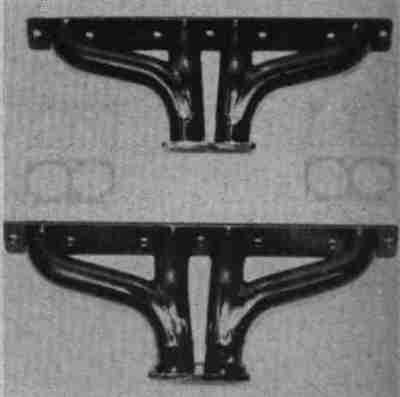 Racing Hedders for 292 and 312.
Racing Hedders for 292 and 312.
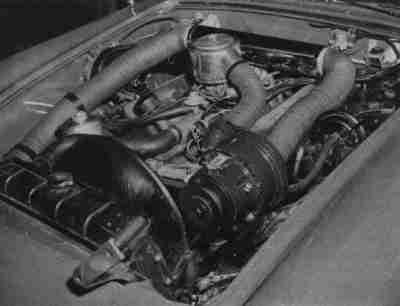 This is a McCulluch centrifugal supercharger installation on a '55
Thunderbird. McCulloch was later bought out by Paxton.
This is a McCulluch centrifugal supercharger installation on a '55
Thunderbird. McCulloch was later bought out by Paxton.
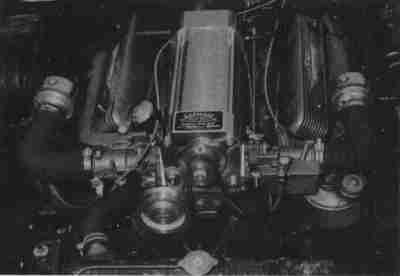 This is an aftermarket Latham axial-flow supercharger on a Thunderbird. The
Latham was very rare and very expensive.
This is an aftermarket Latham axial-flow supercharger on a Thunderbird. The
Latham was very rare and very expensive.
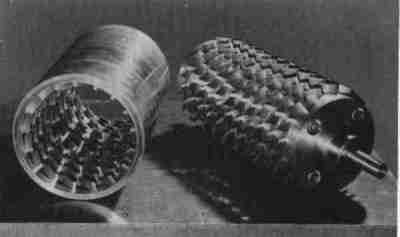 The Latham's turbine compressor worked just like the one on a turbojet engine.
These complex components are why the Latham was so costly.
The Latham's turbine compressor worked just like the one on a turbojet engine.
These complex components are why the Latham was so costly.
 Aftermarket McCulloch installation on a 312 with dual quads. Holes in carb
bonnets are for reed valves to admit air a low RPM when the blower isn't
turning fast enough to feed the engine.
Aftermarket McCulloch installation on a 312 with dual quads. Holes in carb
bonnets are for reed valves to admit air a low RPM when the blower isn't
turning fast enough to feed the engine.